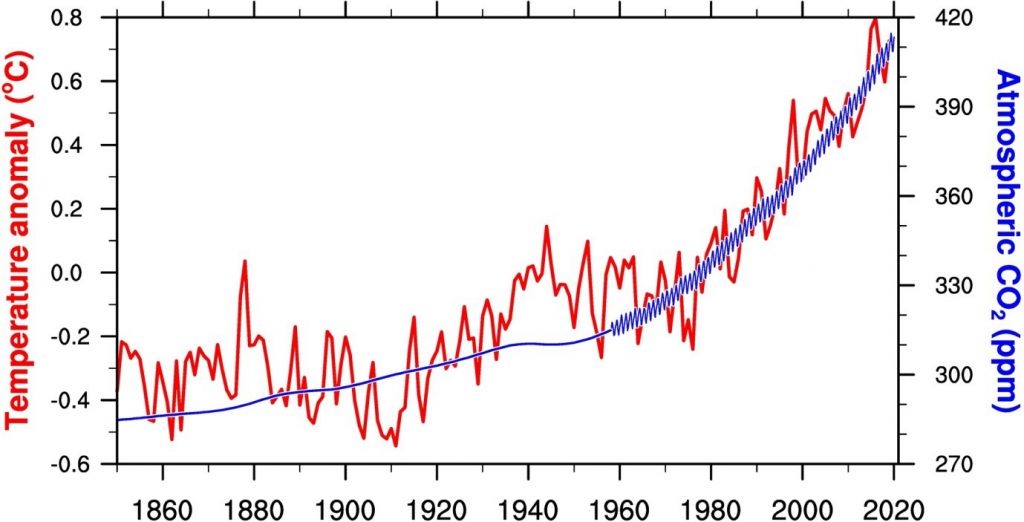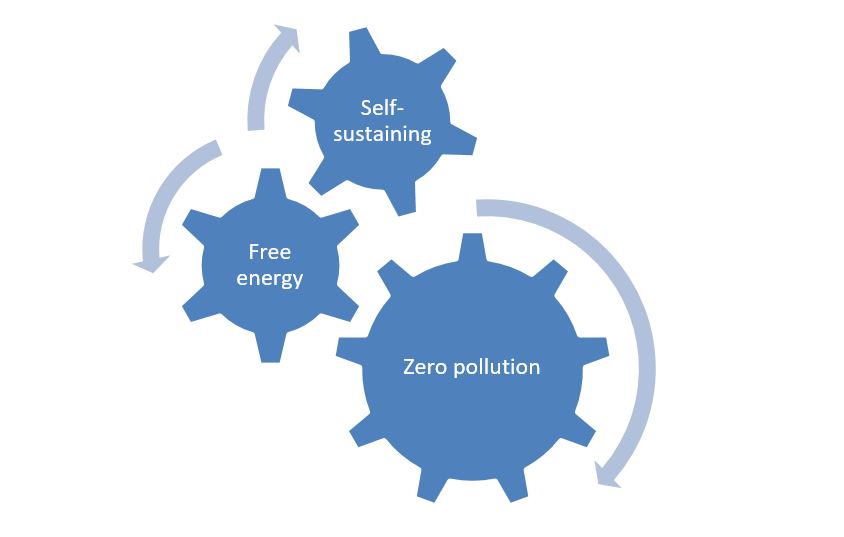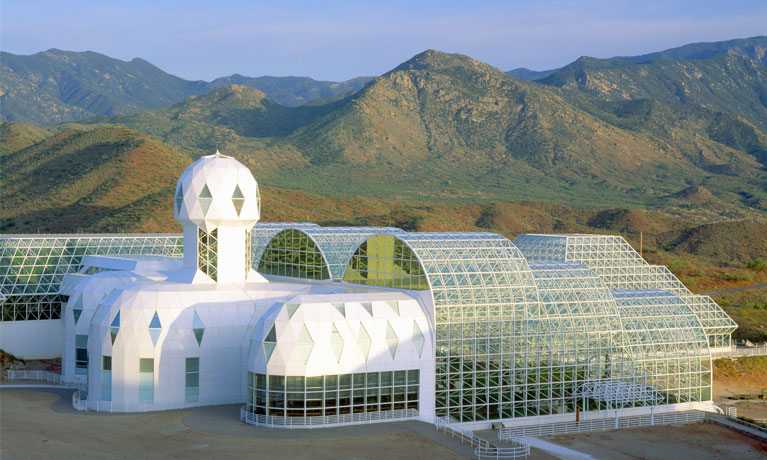By Dr Dennis Chapman
The conditions for Earth to support life are changing rapidly as climate change is destroying the fundamental systems which keep the Earth a moderate and fertile environment for humans and other wild animals. CO2 is increasing in the atmosphere and so is Earth’s average surface temperature. Atmospheric CO2 and temperature are in a “vicious” circle—it is the heat, however, which invariably impacts a myriad of critical Earth systems, such as melting ice caps and glaciers, raising sea levels and corresponding flooding, lengthening droughts causing famine and drying out forests which increases risk of fires, and, most worryingly, collapsing the global ecosystem on which humans and all other animals are dependent.
Figure 1. Global temperature (degrees Celsius) and CO2 (ppm) 1860-2019.

Research at Coventry
The thought experiment being conducted by Dr Chapman, an ASPiRE fellow at Coventry University, considers surviving on Earth in a future in which the vicious cycle of climate change has won out over the “virtuous” circle of Earth’s life eco support systems. This is not such a far stretch of the imagination, as it has become widely accepted the “sixth mass extinction”, and the corresponding beginning of the end to the Anthropocene Age, is already upon us (Barnosky et al. 2011; Schneider 2009).
What is the goal of the research? In engineering terms, the goal is to reduce the rate of entropy of all human life support systems to prepare for a future when resources are not as plentiful as they are now. In short, the research seeks to close the gap between production and consumption in business and society, distilling life to its essentials and building from the “colonisation parsimony model”, something which is already taken for granted on space missions.
Figure 2. Colonisation parsimony model.

An inexpensive and durable material that supports the colonisation parsimony model is “hempcrete”.
“Hempcrete meets condition of eco-friendly material. It is made of renewable resources in sufficient quantity. Production is less energy-intensive [than traditional house building]. It has negative greenhouse gas emissions. It provides resistance and durability construction and healthy living condition. This material is recyclable” (Bedlivá and Isaacs 2014: 86).
Other virtuous circle technologies under research include:
- Geodesic dome building design: uses passive cooling and heating to mitigate temperature in the home year round (Chu 2018; Florez, et al. 2020)
- Solar thermal and wave desalination technology: uses free energy to convert saltwater to fresh water (Davies 2005; Qiblawey and Banat, F. 2007)
- “Alternative” food networks: creates sustainable localised food supply chains to even out the ebb and flow of local supply (Holloway et. al. 2006)
- Go Green to Go Digital (GGGD): Green supercomputing to generate revenue for community and supply universal income (Chapman 2019)
- More “Biosphere 2s” on Earth: Homes and communities adapted to be a part of a sealed (or partially sealed) ecosystem (Nelson 2018).
- Localised energy generation and distribution on decentralised smart grid systems: solar, wind, geothermal, wave and any other renewable energy source that is abundant in the location (Bhatti 2018).
The above is not an exhaustive list of sustainability technologies and systems, but these are the main areas currently under a feasibility study by Dr Chapman. Drawing on existing sustainability research, the contribution of Dr Chapman’s research is that it develops a conceptual framework for building a future even in the “worst case” scenario (Schneider 2009), creating a project programme plan for that contingency, but also creating a 100% sustainable way of life that will allow Earth’s ecosystem time to heal.

Biosphere 2, pictured above, is a project which originally aimed to see if humans could establish self-sustaining living on other planets, e.g. Mars, but which has evolved to support research on climate change and the possibility of living more in harmony with nature on Earth.
One potential criticism of the Earth colonisation project programme is the future of business in such a model. Would there no longer be an incentive to be entrepreneurial? Trade between communities and regions would be possible, and encouraged to maintain an “entrepreneurial economy” (Audretsch and Thurik 2000; Thurik et al. 2013); however, “municipal capitalism” (Lauremann 2016), in which private individuals own the means of production, would come to an end as there would no longer be finite resources to be unevenly distributed. Collective survival would be the only possible way to rebuild life on Terra mortuum.
Summary
According to the 2019 UN Emissions Gap Report, in order for any possible recovery for Earth, humans would have to cut their production as much as 7.6 percent every year for the next decade (UN environment programme 2019). As a logical consequence to implementing colonising Earth now, these reductions could be met and exceeded as humans reduce all pollution to zero. In short, by making the deep changes necessary to live on Terra mortuum, we might save not only ourselves, but also Earth itself.
Bibliography
NOAA.gov (2020) “Carbon dioxide levels in atmosphere hit record high in May” National Oceanic and Atmospheric Administration [online] Available from https://www.noaa.gov/news/carbon-dioxide-levels-in-atmosphere-hit-record-high-in-may [16 Sep 2020]
Bedlivá, H. and Isaacs, N. (2014) “Hempcrete – and environmentally friendly material?” Advanced Materials Research, 1041 (2014), 83-86
Florez, F., Fernández, D.C., Taborda, J. Polo, M. Castro-Palcio, J.C. and María Jezabel Pérez-Quiles (2020) “Sliding Modes Control for Heat Transfer in Geodesic Domes”. Mathematics, 8 (6), 902
Chu, H.Y. (2018) “The Evolution of the Fuller Geodesic Dome: From Black Mountain to Drop City”. Design and Culture 10 (2), 121-137
Davies, P.A. (2005) “Wave-powered desalination: resource assessment and review of technology”. Desalination, 186 (2005), 97-109
Qiblawey, H.M. and Banat, F. (2007) “Solar thermal desalination technologies”. Desalination, 220 (2008), 633-644
Holloway, L., Cox, R., Venn, L., Kneafsey, M. Dowlers, E. and Tuomainens, H. (2006) “Managing sustainable farmed landscape through ‘alternative’ food networks: a case study from Italy”. The geographical journal, 172 (3), 219-229
Chapman, D. (2019) “Go Green Go Digital (GGGD): An applied research perspective toward creating synergy of crypto-mining and sustainable energy production in the UK” ICSMET 2019 [online] Available from https://pure.coventry.ac.uk/ws/portalfiles/portal/28880955/Dennis_Chapman_Extended_AbstractABC.pdf [11/09/20]
Nelson, M. (2018) Pushing our limits: Insights from Biosphere 2. Tucson: University of Arizona Press
Bhatti, H.J. (2018) “Making the World More Sustainable: Enabling Localized Energy Generation and Distribution on Decentralized Smart Grid Systems”. World journal of engineering and technology 6 (2), 350-382
Audretsch, D.B., Thurik, A.R. (2000) “Capitalism and democracy in the 21st century; from the managed to the entrepreneurial economy”. Journal of Evolutionary Economics, 10, 17-34
Lauermann, J. (2018) “Municipal statecraft: Revisiting the geographies of the entrepreneurial city”. Progress in Human Geography, 42 (2), 205-224
UN environment programme (2019) “Emissions Gap Report”. UN Environment Programme [online] Available from https://www.unenvironment.org/resources/emissions-gap-report-2019 [11/09/2020]
Schneider, S. (2009) “The worst case scenario”. Nature, 458 (30), 1104-1105




Comments are disabled